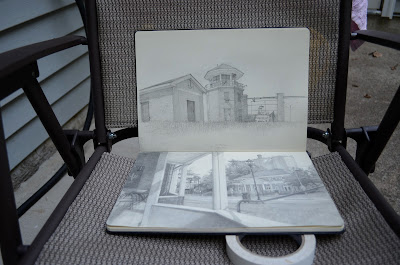Something has to be said about patience, space and the careful study they allow. My family was kind enough not to mind my month-long take over of the dining room, and so I transformed it into a make-shift studio. I had done still life studies before, but it had always been a matter of drawing whatever was before my eyes already. A journalistic sort of approach of noninterference with the objects of study. And then of course there had been arrangements set up by the teachers in the past. Setting up your own still life is an entirely different animal. Every single object, material and color that will end up as part of the painting is your explicit decision. Every shadow, highlight and angle. You aren't adapting your frame of view to the rules of composition, but gardening the composition in its entirety. And then of course, each object will inevitably be infused with personal meaning, even if you aren't going for any sort of explicit metaphor. It took me a couple of days only to set up the arrangement, and on the photos below you can see a couple tripods and a monopod came in very handy for securing the drapery.
Working on a painting a week after week is a meditative, lulling experience, that transforms your habitual way of looking. Beauty of even the most mundane surfaces becomes overwhelming. Your mind continues to analyze and paint, even when you don't have a brush in your hands. And the boundaries of realism become incredibly vast. That is to say that you become very aware just how determinant your choices are to the look of the painting. It may look "realistic," but what an oversimplification that is. You are still, even within realism, essentially choosing between one abstraction and another. You think about parameters that dictate the optical reality before you, eliminate a great deal and emphasize a great deal. You coerce the paint to conform to the shapes you model, once you know how it moves, mixes and reacts.

Practically speaking, another thing comes into play: keeping acrylics active and wet for this long is only possible with an addition of a retardant medium. It makes a world of difference. Your brush will glide, the paint film will still dry fairly quickly, but it stays buttery for long enough to actually work the paint layers and not just patch them one on top of the other. This let me achieve the foggy look of semi-transparent liquid in the wine glass and the striations in the horn pipe from Ollantaytambo.
There isn't a doubt in my mind that realism in painting is a mighty force. Considering it a relic copyist method is simply blind. Ability to accurately relay physical reality of objects in your field of vision is only the beginning, and even that is already an inherently intimate outpouring of the artist's mind. Even as a record of the artist's analysis and decisions, a well orchestrated piece cannot escape from being something mystical and elusive--a connection, an address, a plea for comprehension and harmony, a pocket of reality where laws of physics swap partners. Materials become illusions and thoughts become actualities.
Here is a step by step slideshow of the entire four-week painting session.

































